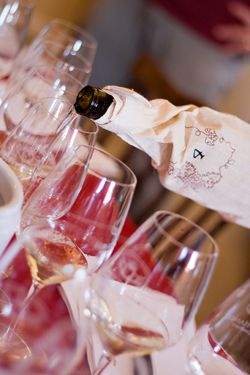
By Evan Dawson, Finger Lakes Editor
Photos by Morgan Dawson Photography
We were getting nowhere. Our initial evaluations of the Finger Lakes white wine flight had produced no clear choice for Wine of the Year. We had summoned only one conclusion:
These were excellent wines and choosing one seemed nearly impossible.
 Slowly we began to pare down the six wines (everything was done blind), and our conversation focused on the search for balance. Which wines showcased the regional strengths most profoundly? We never did reach a unanimous conclusion, which I found healthy. But we were pleased with the selection of Billsboro Winery 2008 Riesling.
Slowly we began to pare down the six wines (everything was done blind), and our conversation focused on the search for balance. Which wines showcased the regional strengths most profoundly? We never did reach a unanimous conclusion, which I found healthy. But we were pleased with the selection of Billsboro Winery 2008 Riesling.
First of all, about 50 cases are still available, selling for $16 — a tremendous value — in the Billsboro tasting room and through BDL Wines in places like Century Liquor in Rochester.
Winemaker Vinny Aliperti describes this wine as "crunchy," referencing the strong dose of natural acid that measures 10.9 grams/liter. But he arrested fermentation to balance the wine with 2.5% residual sugar. The result is a wine that almost ostentatiously displays a long list of regional and varietal characteristics. And it's a wine that is showy, yet crisp and cutting.
This was the first time Aliperti had ever arrested fermentation instead of back-sweetening the riesling for his Billsboro label.
"In theory, arresting fermentation should enhance the way it feels in the mouth," Aliperti says, referencing the fact that a more complex sugar is left in the wine after arresting fermentation as compared to back-sweetening. "But you'd need a pretty large trial to see if that's the case. We're certainly very happy with the way this wine turned out."
We haven't surveyed Finger Lakes winemakers, but it seems safe to say that a majority still prefer to back-sweeten their semi-dry and semi-sweet rieslings. It will be interesting to see if more decide to arrest fermentations.
The fruit for this wine comes from one of the strongest vineyard sites in the Finger Lakes: Sawmill Creek Vineyard on the southeast side of Seneca Lake.
According to Cornell University, this site is one of the steepest in the region, providing excellent air flow and combining with the soils to produce ideal riesling fruit. There is no current hierarchy of Finger Lakes Grand Cru vineyard sites, but this is one that would almost certainly be on such a list.
"Sites like Sawmill and Atwater (Vineyards) give you everything you could want," Aliperti says. "They have the southeast exposure and the steep slope, so you get that late-day sun bouncing up the lake."
Aliperti takes an approach during harvest that some might find surprising. Unlike many of his colleagues, Aliperti does not care to extend the growing season for riesling into November if possible. "I really don't want to see the grapes dehydrate," he says. "Not even a little. I want the grapes to maintain their natural acid while also achieving excellent ripeness, but that doesn't necessarily mean the longest possible hang-time. I've been burned before by waiting too long to pick, and it can affect balance."
While the Finger Lakes white flight was an arduous process for the judges, it was no contest when we brought out the flight for New York White Wine of the Year. The Billsboro stood out quickly for its precision and character.
 The tasting also showcased the challenge for judges when a flight of wines show a range of styles and sugar levels. The Finger Lakes white flight included five rieslings: two were nearly bone dry, one was just under 1% sugar, and the other two measured 2.5% and 2.6%. Making the judging more difficult, the two driest wines were poured last for the judges.
The tasting also showcased the challenge for judges when a flight of wines show a range of styles and sugar levels. The Finger Lakes white flight included five rieslings: two were nearly bone dry, one was just under 1% sugar, and the other two measured 2.5% and 2.6%. Making the judging more difficult, the two driest wines were poured last for the judges.
That's not to say that this was a case of "Low-Cut Dress Syndrome," a phrase coined by writer Matt Kramer to explain why some of the showiest, biggest wines in a flight of red wines often are selected over others. They're easy to enjoy and require less consideration.
Does such a scenario unfold in a flight of white wines, too? I think it's possible. In the future I'd make sure that the dry wines are poured first in such a flight. But when you consider the quality of the Billsboro 2008 Riesling, and the source of the fruit, and the thoughtful approach of an outstanding winemaker, and the combination of power and balance in this wine, the selection of this wine shouldn't surprise anyone.
Wine importer and riesling fanatic Terry Theise recently lamented that dry riesling remains "a niche of a niche market" that he would like to see expand.
Later this year, we'll be writing more about the challenge of making an exceptional dry riesling. Crafting a compelling dry riesling is a difficult art to master. But the success of the Billsboro 2008 Riesling (and the Anthony Road 2008 Semi-Dry Riesing, winner of the Governor's Cup) are an indication that the Finger Lakes can showcase its sense of place at all levels of riesling sweetness. A rich, powerful style can maintain the acidity to balance the flavors, preventing the wine from becoming cloyingly sweet.
There are few better examples than the one produced by Vinny Aliperti at Billsboro.
